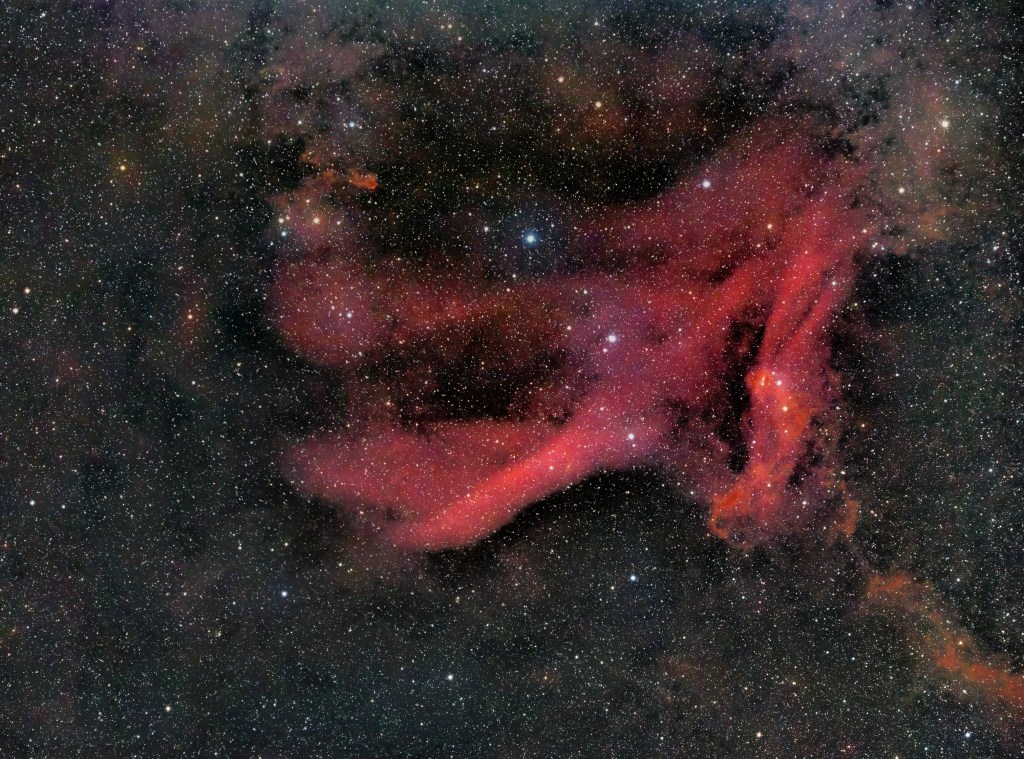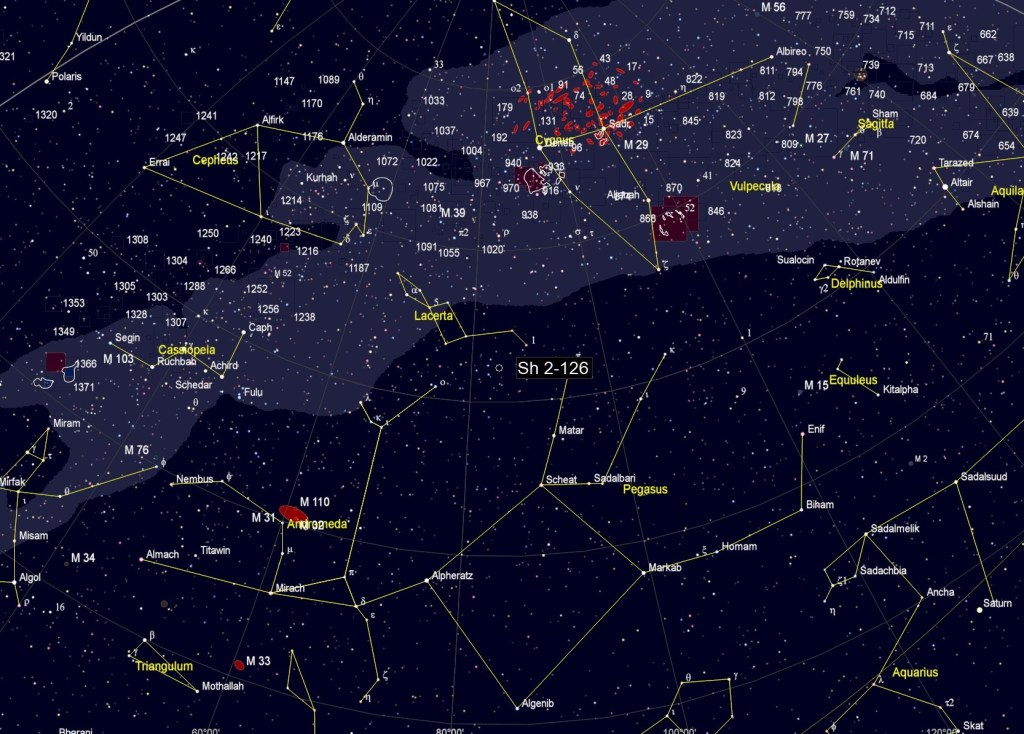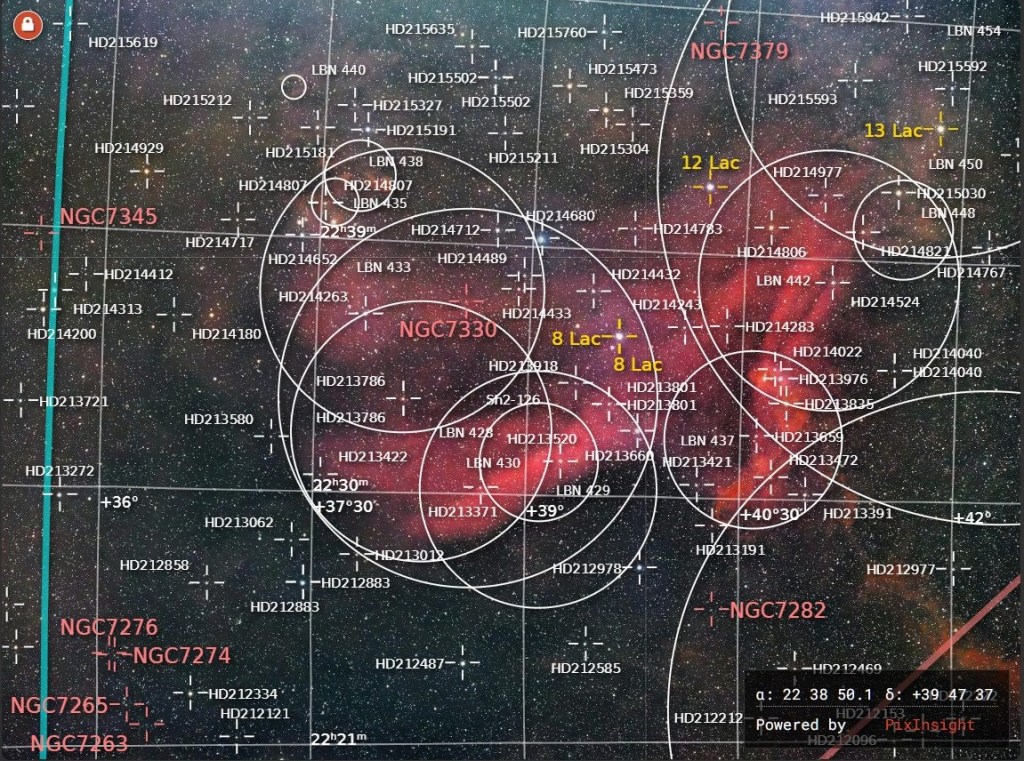
The late summer – early autumn period marks a return of astronomical darkness and therefore for many a return to astronomy. Naturally the iconic objects passing overhead at this time within Cygnus, Cepheus, Pegasus and Andromeda get most attention, so it’s easy to overlook other possibilities such as the less well-known Lacerta (Latin for Lizard) constellation situated between the aforementioned constellations (see skymap below).

Located along the western edge of Milky Way in the southern section of Lacerta, is the large but faint emission nebula SH2-126 AKA the Great Lacerta Nebula (GLN). Consisting of a reddish filament structure with a size of over 3 degrees, the nebula forms a “stellar funnel” at the centre and snaking away to the right is LBN 437 or the Gecko Nebula, a molecular cloud whose denser part is associated with bright young stars; the fascinating structure of the nebula is best seen in the starless Ha image below. The source of ionization is intense ultraviolet radiation from the stars including 10 Lacertae, a blue main sequence star.

This somewhat elusive object requires significant integration time to bring out the detail and colours, which at over 21-hours over 10 nights is the longest I’ve been able to achieve from Fairvale Observatory so far and even that was not without its problems. Moreover, despite this I also found processing to be very difficult, though I’m pleased with the outcome which I believe does justice to this magnificent astrophotography object. Notwithstanding, I hope to return at another time with a bigger FL telescope to take a closer look at the Gecko, which here can just be seen on the right hand side of the GLN.

| IMAGING DETAILS | |
| Object | Sh2-126 Great Lacerta Nebula |
| Constellation | Lacerta |
| Distance | 1,200 light-years |
| Size | >3o |
| Apparent Magnitude | Very faint |
| Scope / Lens | Samyang 135 @f2.8 |
| Mount | SW AZ-EQ6 GT + EQASCOM computer control & Cartes du Ciel |
| Guiding | Sky-Watcher EvoGuide 50ED |
| + Starlight Xpress Lodestar X2 camera & PHD2 guiding | |
| Camera | ZWO1600MM-Cool mono CMOS sensor |
| FOV 7.5o x 5.67o Resolution 5.81”/pix Max. Image Size 4,656 x 3,520 pix | |
| EFW | ZWOx8 EFW & 31mm ZWO LRGB & 7nm Narrowband filters |
| Capture & Processing | Astro Photography Tool + PHD2 + PixInsight v1.8.9-2 |
| Image Location & Orientation | Centre: RA 22:33:27.876 DEC +38:43:49.285 Right = North Top = East |
| Exposures | Ha x136 @ 300 sec, L x87, R x39 G x33 B x37 @ 180 sec Total Integration Time: 21 hr 8 min |
| @ 139 Gain 21 Offset @ -15oC | |
| Calibration | 5 x 300 sec & 10 x 180 sec Darks 20 x Flats & Flat Darks |
| Location & Darkness | Fairvale Observatory – Redhill – Surrey – UK Typically Bortle 5 – 6 |
| Date & Time | 17th November 2022 + 5th 6th 7th 9th September + 6th 7th 8th & 9st October 2023 @ +21.00h |
| Weather | Approx. <=19 oC RH >=55% 🌙 60% waning |
